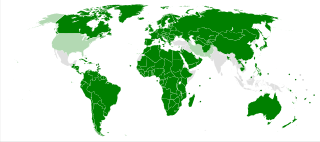Top Qs
Timeline
Chat
Perspective
Protocol II to the Geneva Conventions
1977 amendment protocol to the Geneva Conventions From Wikipedia, the free encyclopedia
Remove ads
Protocol II (also Additional Protocol II or AP II) is a 1977 amendment protocol to the Geneva Conventions relating to the protection of victims of non-international armed conflicts.[citation needed] It defines certain international laws that strive to provide better protection for victims of internal armed conflicts that take place within the borders of a single country. The scope of these laws is more limited than those of the rest of the Geneva Conventions out of respect for sovereign rights and duties of national governments.

State parties (170)
State signatories (3)
Neither
As of July 2025, the Protocol had been ratified by 170 countries, with the United States, India, Pakistan, Turkey, Iran, Iraq, Syria, and Israel being notable exceptions. However, the United States, Iran, and Pakistan signed it on 12 December 1977, which signifies an intention to work towards ratifying it.[3] The Iranian signature was given prior to the 1979 Iranian Revolution.
According to legal scholar and human rights attorney Noura Erakat, the Israeli non-ratification of Protocol I and II to the Geneva Conventions allows the Israeli government to recognize the Israeli-Palestinian conflict ''neither as a civil war ('non-international armed conflict,' NIAC) nor a war against a liberation movement ('international armed conflict,' IAC).''[4] This way, force used by Palestinian factions can be deemed illegal and illegitimate.[4]
Remove ads
Overview
Summarize
Perspective
Historically, international law of armed conflict addressed traditional declarations of war between nations. When the Geneva Conventions were updated in 1949 after the Second World War, delegates sought to define certain minimum humanitarian standards to situations that had all the characteristics of war, without being an international war.[5]
These negotiations resulted in Article 3, common to all four of the basic treaties of the Geneva Conventions of 1949. Common Article 3 applies to armed conflicts that are not of an international character, but that are contained within the boundaries of a single country. It provides limited protection to victims, including:
- Persons taking no active part in hostilities should be treated humanely (including military persons who have ceased to be active as a result of sickness, injury, or detention).
- The wounded and sick shall be collected and cared for.
By the 1970s, diplomats were attempting to negotiate clarifications to the brief language of Article 3, and to extend the scope of international law to cover additional humanitarian rights in the context of internal conflicts. These efforts resulted in Protocol II of the Geneva Conventions. The debate over this protocol centered on two conflicting ideas.[6] First, that the distinction between internal and international armed conflict is artificial from the point of view of a victim. Humanitarian principles should apply regardless of the identity of the combatants. Second, that international law does not apply to non-international situations. A nation has sovereignty within its borders, and must not accept judgments by and orders from other countries. And Article 6, section 2, also prohibits collective punishment.
Remove ads
See also
- Geneva Conventions
- Third Geneva Convention, on the treatment of prisoners of war
- Fourth Geneva Convention, on the treatment of civilians during wartime
- Protocol I, a 1977 amendment adopted addressing the protection of victims in international conflicts
- Protocol III, a 2005 amendment adopted specifying the adoption of the Red Crystal emblem
- List of parties to the Geneva Conventions: includes a list of states that signed and a list of states that have ratified Protocol II
- Law of war, also known as international humanitarian law
- Distinction (law), the principle of distinction between combatants and civilians in armed conflict
Remove ads
References
External links
Wikiwand - on
Seamless Wikipedia browsing. On steroids.
Remove ads
